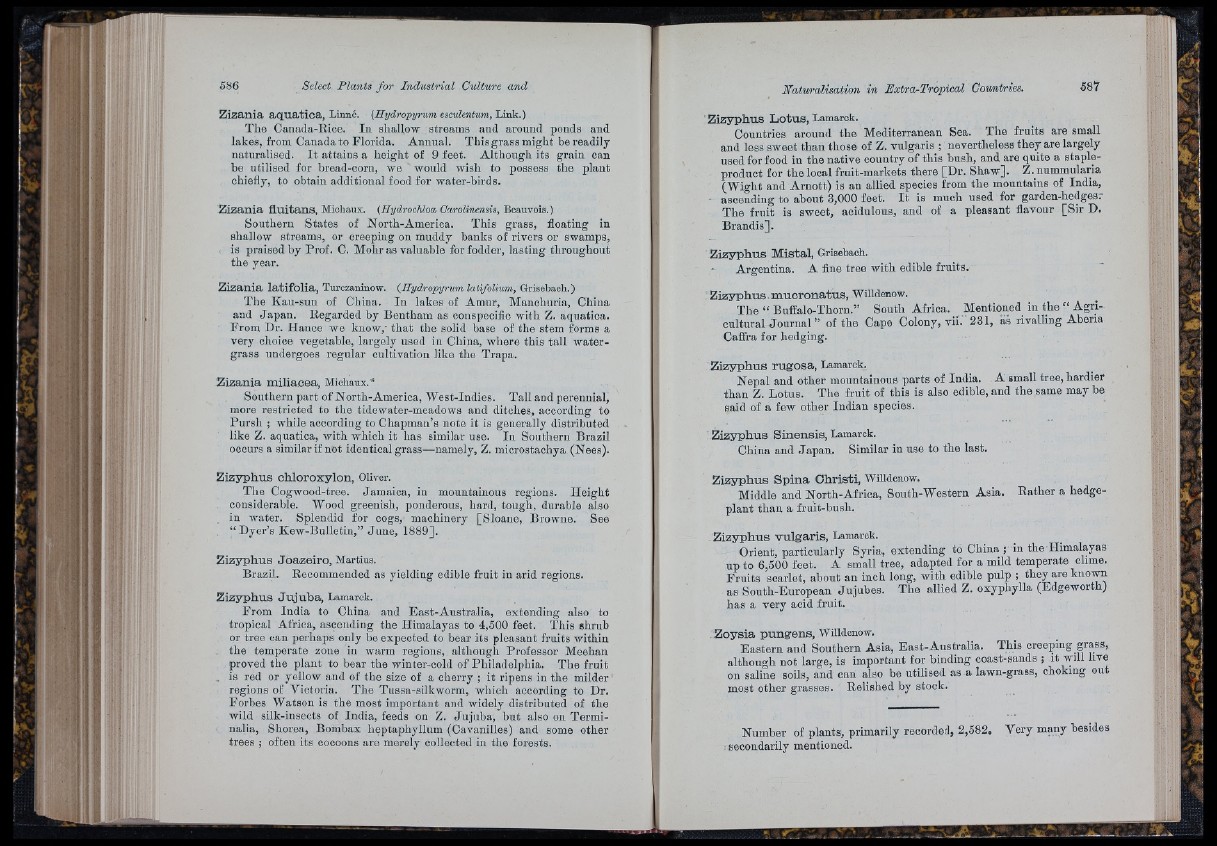
Zizania aquatica, Linné. (Hydropymm esculentum, Link.)
Tlie Canada-Rice. In shallow streams and around ponds and
lakes, from Canada to Florida. Annual. This grass might be readily-
naturalised. I t attains a height of 9 feet. Although its grain can
be utilised for bread-corn, we would wish to possess the plant
chiefly, to obtain additional food for water-birds.
Zizania fluitans, Michaux. {Hydrochloa Oarolinensis, Beauvois.)
Southern States of North-America. This grass, floating in
shallow streams, or creeping on muddy banks of rivers or swamps,
is praised by Prof. C. Mohr as valnable for fodder, lasting throughout
the year.
Zizania latifolia, Turczaninow. {Hydropyrum latifolium, Grisebach.)
The Kan-sun of China. In lakes of Amur, Manchuria, China
and Jap an . Regarded by Bentham as oonspecific with Z. aquatica.
From Dr. Hance we know,’ th a t the solid base of the stem forms a
very choice vegetable, largely used in China, where this tall water-
grass undergoes regular oultivation like the Trapa.
Zizania miliaoea, Michaux.*
Southern part of Nortli-America, West-Indies. Tall and perennial,
more restricted to the tide water-meadows and ditches, according to
Pursh ; while according to Chapman’s note it is generally distributed
like Z. aquatica, with which it has similar use. In Southern Brazil
occurs a similar if not identical grass—namely, Z. microstachya (Nees).
Zizyphus chloroxylon, Oliver.
The Cogwood-tree. Jamaica, iu mountainous regions. Height
considerable. Wood greenish, ponderous, hard, tough, durable also
in water. Splendid for cogs, machinery [Sloane, Browne. See
“ Dyer’s Kew-Bulletin,” June, 1889].
Zizyphus Joazeiro, Martius.
Brazi). Recommended as yielding edible fruit in arid regions.
Zizyphus Jujuba, Lamarck.
From India to China and East-Australia, extending also to
tropical Africa, ascending the Himalayas to 4,500 feet. This shrub
or tree can perhaps only be expected to bear its pleasant fruits within
the temperate zone in warm regions, although Professor Meehan
proved the plant to bear the winter-cold of Philadelphia. The fruit
, is red or yellow and of the size of a cherry ; it ripens in the milder
regions of Victoria. The Tussa-silkworm, which according to Dr.
Forbes Watson is the most important and widely distributed of the
wild silk-inseets of India, feeds on Z. Jujuba, hut also on Terminalia,
Shorea, Bombax heptaphyllum (Cavanilles) aud some other
trees ; often its cocoons are merely collected in the forests.
Zizyphus Lotus, Lamarck.
Countries around th e Mediterranean Sea. The fruits are small
and less sweet than those of Z. vulgaris ; nevertlieless they are largely
used for food in the native country of this hush, and are quite a staple-
product for the local fruit-markets there [Dr. Shaw]. Z. nnmmularia
(Wight and Arnott) is an allied species from the mountains of India,
ascending to ahout 3,000 feet. I t is much used for garden-hedges.-
The fruit is sweet, acidulous, and of a pleasant flavour [Sir D.
Brandis].
Zizyphus Mistal, Grisebach.
Argentina. A fine tree with edible fruits.
Zizyphus mucronatus, Willdenow.
The “ BiifEalo-Thorn.” South Africa. Mentioned iu the “ Agricultural
Journal ” o f th e Cape Colony, v ii." 231, as rivalling Aheria
Caffra for hedging.
Zizyphus rugosa, Lamarck.
Nepal and other mountainous parts of India. A small tree, hardier
than Z. Lotus. The fruit of this is also edible, and the same may he
said of a few other Indian species.
Zizyphus Sinensis, Lamarck.
China and Japan. Similar in use to the last.
Zizyphus Spina Christi, Willdenow.
Middle and North-Africa, South-Western Asia. Rather a hedge-
plant than a fruit-bush.
Zizyphus vulgaris, Lamarck.
Orient, particularly Syria, extending to China ; in the Himalayas
up to 6,500 feet. A small tree, adapted for a mild temperate clime.
F ru its scarlet, ahout an inch long, with edible pulp ; they are kno-wn
as South-European Jujubes. The allied Z. oxyphylla (Edgeworth)
has a very acid fruit.
, Zoysia pungens, Willdenow.
Eastern and Southern Asia, East-Australia. This creeping grass,
although not large, is important for binding coast-sands ; it -will live
on saline soils, and can also be utilised as a lawn-grass, choking out
most other grasses. Relished by stock.
Number of plants, primarily recorded, 2,582. Very matiy besides
secondarily mentioned.